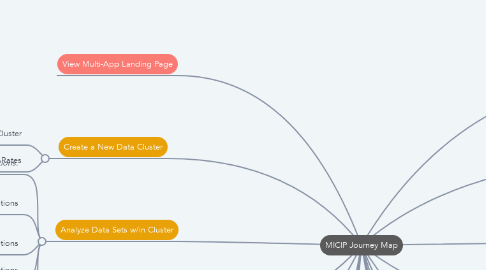
1. View Multi-App Landing Page
2. Create a New Data Cluster
2.1. Name the Cluster
2.2. ex. Factors Affecting Graduation/Drop Out Rates
3. Analyze Data Sets w/in Cluster
3.1. Each set of data within the cluster must be analyzed by answering a series of questions.
3.2. General Trend Questions
3.2.1. ex. "In looking at three years of data, what trends do you identify?"
3.2.2. Answer for Attendance Data Set ex. "Overall attendance rate is dropping with a slight improvement from students with chronic absenteeism."
3.3. Environmental Scan Questions
3.3.1. ex. "What current systems are in the data?"
3.4. Gap Analysis Questions
3.4.1. ex. "What is the desired state (goal) and current state, and whether action is needed, or the current plan is enough?"
3.5. Narrative (text input field)
4. Analyze the Root Cause
4.1. Answer this question: "What causes led to high levels of bullying?"
5. Set Focus Area
5.1. User writes the Focus Area.
5.2. Focus Area ex. "The focus area (goal) is to create opportunities for social and emotional connections to build a school community and reduce bullying."
6. Determine if Focus Area Goal is possible (Scan Summary/Conclusion?)
6.1. This is noted as "Conclusion" in the process document
6.2. Conclusion ex. "Scan results indicated the district has no identifiable area of support towards creating opportunities for social and emotional connections."
7. Prioritize Actions Steps (Strategies)
7.1. First priority action step/strategy selection ex. "School Based: High Schools will add a homeroom into its school day."
8. Share + Submit Plan for Approval
8.1. If Approved
8.2. If Rejected - Review, Edit and Re-submit
9. Monitor Plan
9.1. View Focus Area & Associated Action Plan from Dashboard
9.2. Monitor & Receive Alerts when Data Set Status Changes
10. Decide on Plan Status
10.1. Status examples:
10.1.1. Deselect because the action did not improve the graduation rate
10.1.2. Extend the action with modifications
10.1.3. Maintain the action for extended time with no modifications
10.1.4. Enhance it
11. Definition: A Focus Area is a user-defined goal.
12. SSO Login
12.1. M Login
12.2. MiLaunchPad
13. View MICIP Landing Page
13.1. Content on page:
13.1.1. Access to District, Building, Classroom Views
13.1.2. Discovery Clusters
13.1.3. Monitor Existing Plan/Focus Areas
13.1.4. User Guide
13.1.5. Team Members
14. Add Data Set(s) to Cluster
14.1. Data examples:
14.1.1. Data: Graduation & Drop Out Rates from SY13-14 - SY17-18
14.1.2. Data: Attendance from SY13-14 - SY17-18
14.1.3. Data: ELA M-Step from SY13-14 - SY17-18
14.1.4. Data: Math M-Step from SY13-14 - SY17-18
14.1.5. Data: Violence Survey Results
14.2. Data Sources:
14.2.1. MiDataHub
14.2.1.1. MiSchoolData
14.2.1.2. MiDataExchange
14.2.1.3. MiSurvey
15. Tell the Data Cluster Story
15.1. Answer this "Data Story" question: "Are there any general patterns or connections across all data sets that indicate an understanding of the data?"
15.2. Answer ex. "Bullying appears to have a direct negative affect on graduation and drop out rate as supported by academic and attendance data."
16. Select & Utilize Root Cause Tool
16.1. Tool Examples
16.1.1. 5 Whys
16.1.1.1. ex. "Why is there bullying in our district particularly at the high school level?"
16.1.1.2. ex. "Why is there a lack of social connections?"
16.1.2. Fishbone
16.1.3. Force Field
16.1.4. HEX Tool?
17. Focus Area "Process Using Tool" (Environmental Scan Q's?)
17.1. Environmental Scan questions?
17.1.1. Do you have the resources?
17.1.2. What's the current strategy?
17.1.3. What's the current budget to support this?
17.1.4. What policies are currently in place?
18. Determine Action Steps (Select Strategies)
18.1. Select strategies
18.2. Strategy Sources:
18.2.1. MIStrategyBank
18.2.2. "Others"
18.3. Strategy ex. "School Based: High Schools will add a homeroom into its school day."
19. Define Implementation Steps
19.1. Answer the following questions:
19.1.1. Who will do it?
19.1.2. What will they do?
19.1.3. When will they do it?
19.1.4. How will they do it?
19.1.5. Are tiered supports necessary for students, staff, and families?
19.1.6. Why will they do it?
19.1.7. What is the target success criteria?
19.1.8. If action is a non-academic target, what academic target will also be impacted?
19.1.9. How will it be funded?
19.1.10. What systems need to be in place to support it?
19.1.11. What will they do to ensure these systems are in place?
19.1.12. What is the plan for monitoring implementation and impact?
19.1.13. What is the plan for evaluation of implementation and impact?
19.1.14. How will parents and community be engaged?
19.1.15. How will the plan be communicated?
19.1.15.1. List all communication sources.

